The third time is the charm
Sunday-Thursday June 10-14, 2007Zion National Park
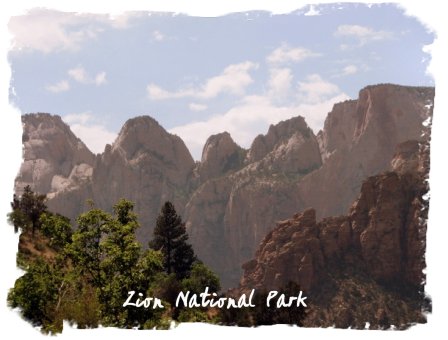
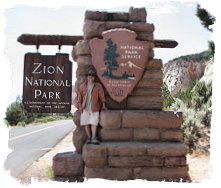 Zion is my favorite National Park. I’m not sure why – I usually prefer lush landscapes to dry, desert rock. However, there is something majestic and ethereal about Zion – even on my 3rd visit to the park, I was still awestruck at the initial view from the mouth of the Mt. Carmel tunnel. It is easy to see why the Mormons named the place after the City of Heaven.
Zion is my favorite National Park. I’m not sure why – I usually prefer lush landscapes to dry, desert rock. However, there is something majestic and ethereal about Zion – even on my 3rd visit to the park, I was still awestruck at the initial view from the mouth of the Mt. Carmel tunnel. It is easy to see why the Mormons named the place after the City of Heaven.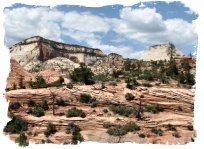 The best way to approach Zion is from the east on Hwy 9. After driving about 20 miles through rolling desert hills, the scenery abruptly changes character, entering you into a colorful world of shapely, dramatic sandstone domes and canyons. There are two tunnels entering Zion, the second being the famous Mt. Carmel tunnel. Constructed by the Union Pacific railroad to provide road access for tourists, the mile long tunnel is just inside the canyon wall, with a unique set of windows or ‘galleries’ that open up brief vistas.
The best way to approach Zion is from the east on Hwy 9. After driving about 20 miles through rolling desert hills, the scenery abruptly changes character, entering you into a colorful world of shapely, dramatic sandstone domes and canyons. There are two tunnels entering Zion, the second being the famous Mt. Carmel tunnel. Constructed by the Union Pacific railroad to provide road access for tourists, the mile long tunnel is just inside the canyon wall, with a unique set of windows or ‘galleries’ that open up brief vistas. The old tunnel is not high enough at the edges to accommodate oversized vehicles (i.e. campers). The solution is to run traffic one way at a time right down the middle of the tunnel! RV’s and the such are charged an extra $15 for the privilege, which I was happy to pay. There is a 50 foot length limit on towed vehicles, which I never gave a second thought to until the ranger started measuring us. Either we were lucky, or the ranger liked me, because the final measurement was 49 feet, 11 & 15/16th inches! I rapidly understood the reasoning behind the limitation, as Hwy 9 is a narrow, twisty road with numerous rock ledges hanging around corners to snag the careless driver. I had to pay extra attention to navigating the camper around the curves, which is hard in the midst of such spectacular scenery.
The old tunnel is not high enough at the edges to accommodate oversized vehicles (i.e. campers). The solution is to run traffic one way at a time right down the middle of the tunnel! RV’s and the such are charged an extra $15 for the privilege, which I was happy to pay. There is a 50 foot length limit on towed vehicles, which I never gave a second thought to until the ranger started measuring us. Either we were lucky, or the ranger liked me, because the final measurement was 49 feet, 11 & 15/16th inches! I rapidly understood the reasoning behind the limitation, as Hwy 9 is a narrow, twisty road with numerous rock ledges hanging around corners to snag the careless driver. I had to pay extra attention to navigating the camper around the curves, which is hard in the midst of such spectacular scenery.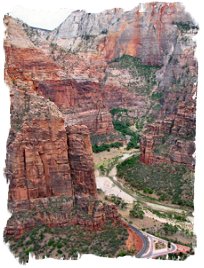 Once you pop out of the tunnel is where the real fun begins. As the road snakes down a series of switchbacks on the canyon wall, the view is almost unbelievable. The richly colored, nearly vertical walls of Zion Canyon are what set it apart. Simply beautiful.
Once you pop out of the tunnel is where the real fun begins. As the road snakes down a series of switchbacks on the canyon wall, the view is almost unbelievable. The richly colored, nearly vertical walls of Zion Canyon are what set it apart. Simply beautiful.I had been unsuccessful at landing a campsite at Zion during my previous two visits, despite camping in a pup tent both times. However, the third time is the charm, and too my considerable surprise I was able to get a reserved site in the main campground with electricity.
This was wonderful – the visitor center and shuttle pavilion was a short walk down alongside the Virgin River, and there was also a pedestrian bridge to nearby Springdale, Utah. I just love being able to walk to restaurants and groceries, and the setup in the Watchman campground provided for this. Vance was able to hookup immediately with some other children to play with, as well as a young Asian boy whose parents worked at a nearby Thai restaurant.
Staying in the park provided several unexpected benefits, not the least avoiding the lines of cars at the gates, and competing for parking spaces at the Visitor Center. The view from our camper of the 'Watchman' was spectacular, and the cool Virgin River was a nice diversion after a hot day.

We always immediately look into Junior Ranger programs at the parks, and this is where Zion really shined. In addition to their normal program, they also offered ‘Explorer’ and ‘Discover’ Jr. Ranger events. The Explorer event was a 3 hour ranger conducted class, held at the Zion Nature Center.
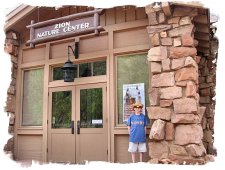 This was a drop-off program, so Denise and I were able to take a ranger guided tour of the canyon via shuttle while Vance learned about bats, a subject he already knows a good deal about from our visit to Carlsbad Caverns. Just having a few hours to ourselves was wonderful – if for no other reason we were grateful to the Park Service for the babysitting! Vance enjoyed the program, particularly being around a lot of other kids, including one boy he had met at Arches NP!
This was a drop-off program, so Denise and I were able to take a ranger guided tour of the canyon via shuttle while Vance learned about bats, a subject he already knows a good deal about from our visit to Carlsbad Caverns. Just having a few hours to ourselves was wonderful – if for no other reason we were grateful to the Park Service for the babysitting! Vance enjoyed the program, particularly being around a lot of other kids, including one boy he had met at Arches NP!Whenever possible, Denise and I try to take advantage of ranger led programs offered in the parks. In Zion, we took 2 ranger led hikes (one up to Scouts Landing, another on an off trail hike to the base of the Three Patriarchs by a ranger who greatly resembled Rosie O’Donnell! In addition we attended several evening programs, the amphitheater located just a couple of campsites over. Some programs are better than others, but we usually always manage to learn something. Denise particularly enjoyed a program on ‘Hidden Zion’, discussing the little seen night creatures in the area, presented by a ranger with a dry, sardonic wit. Vance, although you never can tell if he is really paying attention, almost never fails to mention something he heard at one of these programs several days later.
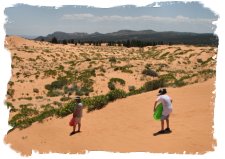 Because of the heat (it would reach the 100’s in the early afternoon), we tried to do most of our outdoor activities early or in late afternoon. We found time for some side trips – first to Coral Pink Sane Dunes State Park. Vance was hoping to sled on the dunes, like at White Sands. We had a nice picnic, but the sledding attempt proved fruitless. Although plenty high, the sled just wouldn’t slide through the pinkish sand. Plus the sand was extremely hot! Coral Dunes is a favorite with the motorcycle and ATV crowd, and we watched a whole group of bikers playing on the dunes. Looked like fun….
Because of the heat (it would reach the 100’s in the early afternoon), we tried to do most of our outdoor activities early or in late afternoon. We found time for some side trips – first to Coral Pink Sane Dunes State Park. Vance was hoping to sled on the dunes, like at White Sands. We had a nice picnic, but the sledding attempt proved fruitless. Although plenty high, the sled just wouldn’t slide through the pinkish sand. Plus the sand was extremely hot! Coral Dunes is a favorite with the motorcycle and ATV crowd, and we watched a whole group of bikers playing on the dunes. Looked like fun….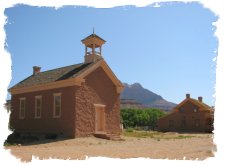 Another side trip was to view Grafton. Down the Virgin River about 10 miles from the canyon entrance, Grafton is an old Mormon settlement now turned ghost town. Denise and I had browsed around the little village on our trip in ’93. Today, the Grafton Historical Association has begun to restore some of the buildings. Grafton was used to film the bicycle scene in Butch Cassidy and the Sundance Kid (with ‘Raindrops keep falling on my head’ as the soundtrack). The little cemetery is fascinating, as Mormon skirmishes with the local Indians are recorded on several tombstones – Killed by Indians.
Another side trip was to view Grafton. Down the Virgin River about 10 miles from the canyon entrance, Grafton is an old Mormon settlement now turned ghost town. Denise and I had browsed around the little village on our trip in ’93. Today, the Grafton Historical Association has begun to restore some of the buildings. Grafton was used to film the bicycle scene in Butch Cassidy and the Sundance Kid (with ‘Raindrops keep falling on my head’ as the soundtrack). The little cemetery is fascinating, as Mormon skirmishes with the local Indians are recorded on several tombstones – Killed by Indians.
Further up the road is one of my favorite sections of the park, the little visited Kolob Canyons district. Photos do not do this area justice. Kolob Canyons is a series of large finger canyons all coming to a point on the same bluff. The view from the final overlook is as dramatic as you can find anywhere, and if you are lucky enough to see it shortly after a rain, it is mind boggling beautiful. At one time Kolob Canyons was a National Monument, later absorbed into Zion National Park. In some ways, this is a shame that it isn’t still a stand alone entity because it is overshadowed by the Zion Canyon portion of the park. However, it is a stunning and beautiful setting in its own right. I think many people overlook this part of Zion, which is their loss.
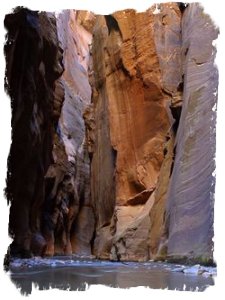 The highlight of Zion is the 'Narrows', one of the most famous slot canyons in the world. Here, the vertical sandstone walls crowd the Virgin River to form a spectacular, narrow gash in the early. The Narrows Hike is one of the more popular in the park. There is no trail - you hike up the river! For years I kept a poster of the Zion Narrows in my office at work, and it's been my goal on each of my three Zion trips to hike it.
The highlight of Zion is the 'Narrows', one of the most famous slot canyons in the world. Here, the vertical sandstone walls crowd the Virgin River to form a spectacular, narrow gash in the early. The Narrows Hike is one of the more popular in the park. There is no trail - you hike up the river! For years I kept a poster of the Zion Narrows in my office at work, and it's been my goal on each of my three Zion trips to hike it.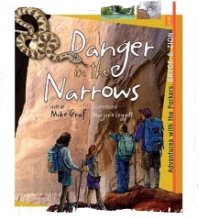
But the best laid plans of mouse and men....for whatever reason, it simply hasn't worked out. I figured Vance would be all for the hike in the river, but after reading 'Danger in the Narrows', a kids adventure book about Zion (given to him by the campground owner of the Bryce KOA), he's refused to even consider it. In the book, the father in the family is badly hurt in the Narrows, requiring an overnight stay and a rescue. I think between this, and our other couple of hikes, Vance had all he cared for as far as hiking in Zion was concerned. We got him as far as the end of the Riverside Trail, which is the put in point for the Narrows Hike. But that was it. Maybe Denise and I will come back to Zion (soon we hope) for a couples trip and experience the Narrows!
Dealing with the masses
Overcrowding is a serious issue in many of the National Parks. Zion, in particular, faced a growing crisis with the number of cars entering Zion Canyon. To give you an idea, on a daily average, 5000 cars would enter the park, vying for about 450 parking spaces. Note this is an average, which means during the summer months, the number of cars was actually higher. I do remember waiting for parking during previous trips to the park, and the long line of cars parked on the side of the road. One of the downsides to the more popular parks is the fact they have turned into large parking lots for the most part.Shuttle systems are being adopted in some of the parks. Bryce (and the Grand Canyon, which we visited before I wrote this) have free shuttle systems in the park, but allow cars in all but a few sections. Zion allows traffic on an east-west axis along Highway 9, but the 7 mile road back towards the narrows section of the canyon is now closed, except for shuttles and those lucky few staying at the Zion Lodge.
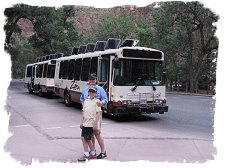 This is a great solution – the propane powered shuttles are clean, run often, and are quiet compared to the general bustle of automobiles. Vents in the roof are opened to draw in a fresh stream of air, providing relief from the heat. The shuttle drivers provide a running monologue on the park – one driver in particular was funny, entertaining and his spiel was as good as any of the ranger programs we attended. The shuttle system was well designed and quite effective.
This is a great solution – the propane powered shuttles are clean, run often, and are quiet compared to the general bustle of automobiles. Vents in the roof are opened to draw in a fresh stream of air, providing relief from the heat. The shuttle drivers provide a running monologue on the park – one driver in particular was funny, entertaining and his spiel was as good as any of the ranger programs we attended. The shuttle system was well designed and quite effective.The best part is now the back section of the canyon road looks and sounds like a National Park should. It is quiet – the buses run on an 8 min schedule during the day, so in between shuttles the roadway is largely empty. The park reports a gratifying return of many animals to the valley floor – mule deer, fox, turkey and even the rare spotting of a mountain lion. Biking is allowed on the roadway, and I was sorely tempted to ride up and down the canyon road if time and circumstance had allowed.
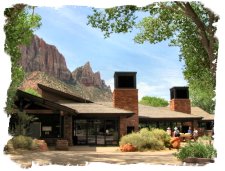 The Visitor Center is new, and green. A design criterion was to make the building as sustainable as possible. The center is cooled using ‘cooling towers’, where water is evaporated in a set of baffles, drawing down cool, moist air into the building. It was simply delicious to sit in front of one of the vents, allowing the naturally cooled air to wash over you. Heating is by passive solar.
The Visitor Center is new, and green. A design criterion was to make the building as sustainable as possible. The center is cooled using ‘cooling towers’, where water is evaporated in a set of baffles, drawing down cool, moist air into the building. It was simply delicious to sit in front of one of the vents, allowing the naturally cooled air to wash over you. Heating is by passive solar.Quoting the US Department of Energy website about the Zion Facility:
Several effective energy features were included in this project: daylighting, Trombe walls for passive solar heating, downdraft cooltowers for natural ventilation cooling, energy-efficient lighting, and advanced building controls. A roof-mounted photovoltaic (PV) system provides electric power. This project will save roughly $14,000 and about 10 kW of electric demand per year through these energy-saving measures.
Green energy is becoming somewhat of a focus of mine, so I found the design of the building fascinating (as well as the Clinton Library and the Heifer International Headquarters in Little Rock. It’s good to see the Park Service take a lead in the use of sustainable technologies.

Vance: Zion is Dad’s favorite NP. They have a tunnel that has huge windows on the side. The Great Arch of Zion is right outside the tunnel. Dad was shocked to find we could get to camp in the park.
We did a hard hike up to Scout’s Lookout. I saw a very pretty bird up there. Dad tried to hike up Angel’s Landing, but chickened out. He had a voice in his head saying, “ Okay, you’re about to fall over and kill yourself.” We did lots of hikes in Zion.
I WOULD HAVE HAD THE SAME VOICE IN MY HEAD AS DAD’S IF I WENT UP ANGEL’S LANDING!
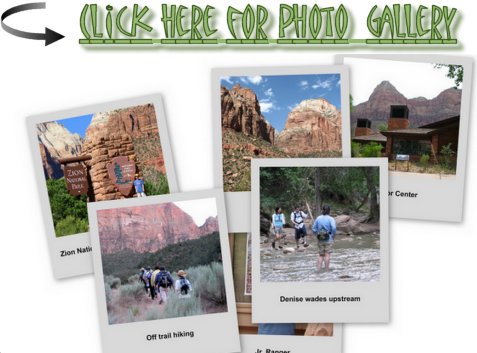
| Previous - Hoodoos on Horseback | | Home | Index | | Facing Limits - Next |







<< Home